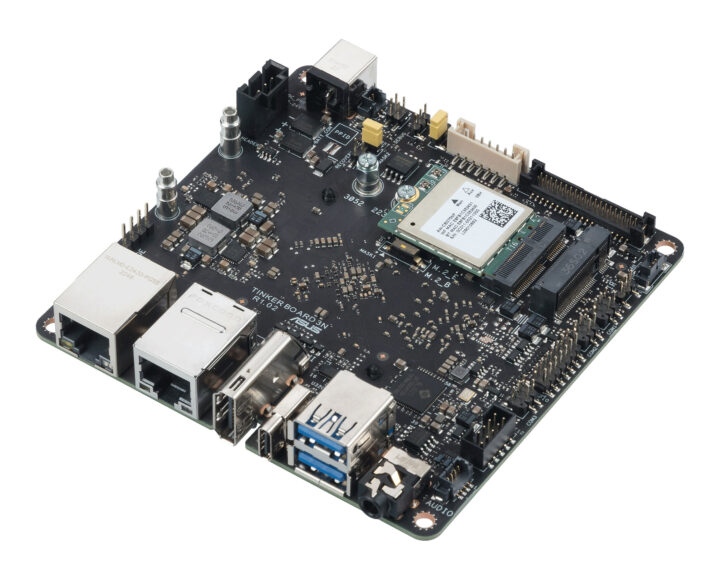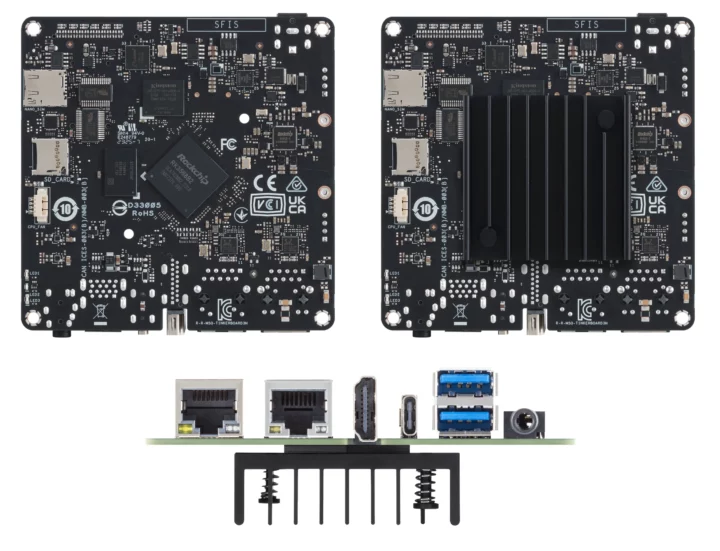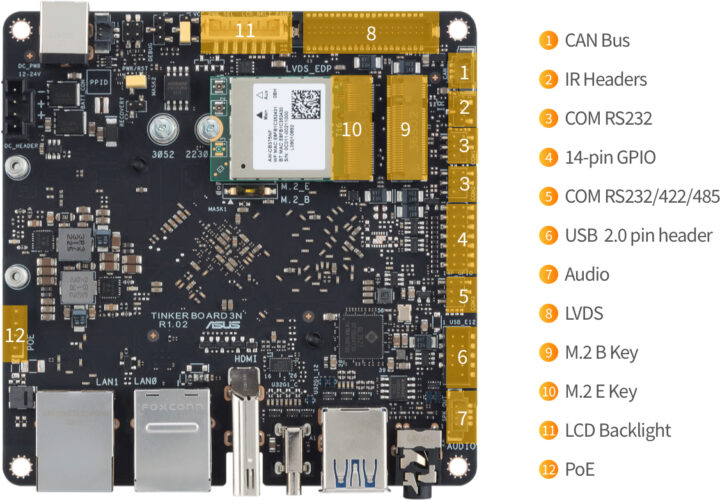The ASUS Tinker board 3 was first unveiled in April 2023 before being renamed as Tinker Board 3N later that year, and the three variants of the Rockchip RK3568 single board computer (SBC) are now available.
The standard configuration is the Tinker Board 3N in the commercial temperature range, while the Tinker Board 3N Plus has the same features, except it can operate in the industrial temperature range (-40°C to 85°C). The Tinker Board 3N Lite is a cost-down version in the same form factor, but with a single gigabit Ethernet port without PoE support, no M.2 B-key socket for an NVMe SSD or 4G/5G cellular connectivity, no 16MB SPI flash, fewer serial interfaces, and no CAN Bus.
 You’ll find a comparison of the specifications for the three variants in the table below.
You’ll find a comparison of the specifications for the three variants in the table below.
Tinker Board 3N Lite | Tinker Board 3N | Tinker Board 3N Plus |
|
|---|---|---|---|
| SoC | |||
| System Memory | 2GB, 4GB, or 8GB LPDDR4/LPDDR4X | 2GB or 4GB LPDDR4/LPDDR4X |
|
| Storage | Optional 32GB/64GB eMMC flash MicroSD card slot | Optional 32GB/64GB eMMC flash MicroSD card slot NVMe SSD via M.2 B-Key socket 16MB SPI flash |
|
| Display | 1x HDMI with CEC hardware ready 1x LVDS (Dual-link) 1x eDP |
||
| Audio | 3.5mm headphone jack Stereo speaker header (4 Ohm, 3W each) HDMI audio |
||
| Networking | 1x RJ45 gigabit Ethernet port Optional Wi-Fi 5/6 & BT module via M.2 E-Key 2230 (PCIe 2.0 x1, USB 2.0) socket | 2x RJ45 gigabit Ethernet ports with optional PoE support Optional Wi-Fi 5/6 & BT module via M.2 E-Key 2230 (PCIe 2.0 x1, USB 2.0) socket Optional 4G/5G or SSD module via M.2 B key 3042/3052 (PCIe 3.0 x1, USB 3.0, USB 2.0, SIM) socket with with nano-SIM slot |
|
| USB | 1x USB 3.2 Gen1 Type-C OTG port 2x USB 3.2 Gen1 Type-A ports 2x USB 2.0 Pin header |
||
| Serial | RS232/RS422/RS485 via header RS232 via header | RS232/RS422/RS485 via header 2x RS232 via header CAN Bus 2.0B FD via header |
|
| Expansion | 14-pin GPIO headers with GND, I2C bus, up to 2x UART, 1x SPI, 1x SPDIF, 4x PWM, 2x 8-bit ADC |
||
| MIsc | IR receiver header 2-pin recovery header 4-pin Power-on & Reset header 3-pin Debug UART header 4-pin DC fan header 2-pin RTC Battery header |
||
| Power Supply | 12V-24V DC via power barrel jack or 4-pin Power In Header |
||
| Dimensions | 100 x 100 mm |
||
| Temperature Range | 0 to 60°C | -40 to +85°C |
|
| Humidity | 10% to 85% (Non condensing) |
||
| Longevity | 7 years |
||
| Price | $169.99 (4GB/64GB) | $179.10 (4GB/32GB) | $251.10 (4GB/32GB) |
Note the prices above are from Amazon with a 10% discount when applicable.
 ASUS provides support for Debian 11 and Android 12 operating systems for the Tinker Board 3N with support for the ASUS IoT Cloud Console and firmware over-the-air (FOTA) updates support. Documentation such as the user manual, drawing & schematics, and Qualified Vendors List (QVL) – i.e. devices tested to be compatible – can be found on the Tinker board website. Some instructions to build the Linux image can also be found on GitHub.
ASUS provides support for Debian 11 and Android 12 operating systems for the Tinker Board 3N with support for the ASUS IoT Cloud Console and firmware over-the-air (FOTA) updates support. Documentation such as the user manual, drawing & schematics, and Qualified Vendors List (QVL) – i.e. devices tested to be compatible – can be found on the Tinker board website. Some instructions to build the Linux image can also be found on GitHub.
All three boards can be purchased on Amazon starting at $169.99 for the Lite variant with 4GB RAM and 64GB eMMC flash, and $179.10 and $251.10 for the Standard and Plus models respectively after ticking for a 10% discount coupon. ASUS has an extensive distribution network, so it may pay to shop around, and for instance, Rutronik24’s pricing may be more attractive to European customers, although it’s still fairly pricey for a Rockchip RK3568 board considering you can have similarly featured alternatives such as Radxa Rock 3B or Hardkernel ODROID-M1 at significantly lower price.
Via Liliputing

Jean-Luc started CNX Software in 2010 as a part-time endeavor, before quitting his job as a software engineering manager, and starting to write daily news, and reviews full time later in 2011.
Support CNX Software! Donate via cryptocurrencies, become a Patron on Patreon, or purchase goods on Amazon or Aliexpress





